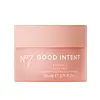What's inside
What's inside
 Key Ingredients
Key Ingredients

 Benefits
Benefits

 Concerns
Concerns

 Ingredients Side-by-side
Ingredients Side-by-side

Water
Skin ConditioningPropanediol
SolventDipropylene Glycol
HumectantButylene Glycol
HumectantMethylpropanediol
SolventDiethoxyethyl Succinate
SolventEthoxydiglycol
HumectantAmmonium Acryloyldimethyltaurate/Beheneth-25 Methacrylate Crosspolymer
Emulsion StabilisingNiacinamide
SmoothingTrehalose
Humectant1,2-Hexanediol
Skin ConditioningChlorella Vulgaris Extract
Skin ConditioningCollagen
MoisturisingHydrolyzed Collagen
EmollientCynanchum Atratum Extract
Skin ConditioningAlthaea Rosea Flower Extract
Skin ConditioningSoluble Collagen
HumectantAllium Sativum Bulb Extract
Skin ConditioningAvena Sativa Kernel Extract
AbrasiveBertholletia Excelsa Seed Extract
Skin ConditioningBrassica Oleracea Italica Extract
AstringentCamellia Sinensis Seed Extract
HumectantSalmon Egg Extract
Solanum Lycopersicum Fruit Extract
AntioxidantSpinacia Oleracea Leaf Extract
Skin ConditioningVaccinium Angustifolium Fruit Extract
Skin ProtectingWine Extract
AntioxidantPolyglyceryl-10 Isostearate
Skin ConditioningTromethamine
BufferingGlucose
HumectantPolyglyceryl-10 Oleate
Skin ConditioningEthylhexylglycerin
Skin ConditioningFructooligosaccharides
HumectantFructose
HumectantAdenosine
Skin ConditioningSodium Phytate
Cyanocobalamin
Skin ConditioningTocopherol
AntioxidantPullulan
Glycerin
HumectantHydroxypropyltrimonium Hyaluronate
Squalane
EmollientSoluble Proteoglycan
Skin ConditioningHydrolyzed Elastin
EmollientSodium Dna
Skin ConditioningCarbomer
Emulsion StabilisingXanthan Gum
EmulsifyingParfum
MaskingWater, Propanediol, Dipropylene Glycol, Butylene Glycol, Methylpropanediol, Diethoxyethyl Succinate, Ethoxydiglycol, Ammonium Acryloyldimethyltaurate/Beheneth-25 Methacrylate Crosspolymer, Niacinamide, Trehalose, 1,2-Hexanediol, Chlorella Vulgaris Extract, Collagen, Hydrolyzed Collagen, Cynanchum Atratum Extract, Althaea Rosea Flower Extract, Soluble Collagen, Allium Sativum Bulb Extract, Avena Sativa Kernel Extract, Bertholletia Excelsa Seed Extract, Brassica Oleracea Italica Extract, Camellia Sinensis Seed Extract, Salmon Egg Extract, Solanum Lycopersicum Fruit Extract, Spinacia Oleracea Leaf Extract, Vaccinium Angustifolium Fruit Extract, Wine Extract, Polyglyceryl-10 Isostearate, Tromethamine, Glucose, Polyglyceryl-10 Oleate, Ethylhexylglycerin, Fructooligosaccharides, Fructose, Adenosine, Sodium Phytate, Cyanocobalamin, Tocopherol, Pullulan, Glycerin, Hydroxypropyltrimonium Hyaluronate, Squalane, Soluble Proteoglycan, Hydrolyzed Elastin, Sodium Dna, Carbomer, Xanthan Gum, Parfum
Dimethicone
EmollientWater
Skin ConditioningDipropylene Glycol
HumectantButylene Glycol
HumectantGlycerin
HumectantGlycereth-26
HumectantSaccharomyces/Rice Ferment Filtrate
Skin ConditioningCetearyl Alcohol
EmollientPEG-100 Stearate
Glyceryl Stearate
EmollientRosa Damascena Flower Water
MaskingDimethiconol
Emollient1,2-Hexanediol
Skin ConditioningHydroxyacetophenone
AntioxidantPentylene Glycol
Skin ConditioningDimethicone/Vinyl Dimethicone Crosspolymer
Skin ConditioningSaccharomyces/Zinc Ferment
Skin ConditioningPEG-150 Distearate
EmulsifyingAmmonium Acryloyldimethyltaurate/Vp Copolymer
Tocopherol
AntioxidantEthylhexylglycerin
Skin ConditioningCamellia Japonica Seed Oil
EmollientAllantoin
Skin ConditioningSodium Hyaluronate
HumectantLinoleic Acid
CleansingCI 14700
Cosmetic ColorantDimethicone, Water, Dipropylene Glycol, Butylene Glycol, Glycerin, Glycereth-26, Saccharomyces/Rice Ferment Filtrate, Cetearyl Alcohol, PEG-100 Stearate, Glyceryl Stearate, Rosa Damascena Flower Water, Dimethiconol, 1,2-Hexanediol, Hydroxyacetophenone, Pentylene Glycol, Dimethicone/Vinyl Dimethicone Crosspolymer, Saccharomyces/Zinc Ferment, PEG-150 Distearate, Ammonium Acryloyldimethyltaurate/Vp Copolymer, Tocopherol, Ethylhexylglycerin, Camellia Japonica Seed Oil, Allantoin, Sodium Hyaluronate, Linoleic Acid, CI 14700
 Reviews
Reviews

Ingredients Explained
These ingredients are found in both products.
Ingredients higher up in an ingredient list are typically present in a larger amount.
1,2-Hexanediol is a synthetic liquid and another multi-functional powerhouse.
It is a:
- Humectant, drawing moisture into the skin
- Emollient, helping to soften skin
- Solvent, dispersing and stabilizing formulas
- Preservative booster, enhancing the antimicrobial activity of other preservatives
Butylene Glycol (or BG) is used within cosmetic products for a few different reasons:
Overall, Butylene Glycol is a safe and well-rounded ingredient that works well with other ingredients.
Though this ingredient works well with most skin types, some people with sensitive skin may experience a reaction such as allergic rashes, closed comedones, or itchiness.
Learn more about Butylene GlycolDipropylene Glycol is a synthetically created humectant, stabilizer, and solvent.
This ingredient helps:
Dipropylene glycol is technically an alcohol, but it belongs to the glycol family (often considered part of the ‘good’ alcohols). This means it is hydrating and gentle on skin unlike drying solvent alcohols like denatured alcohol.
As a masking agent, Dipropylene Glycol can be used to cover the smell of other ingredients. However, it does not have a scent.
Studies show Dipropylene Glycol is considered safe to use in skincare.
Learn more about Dipropylene GlycolEthylhexylglycerin (we can't pronounce this either) is commonly used as a preservative and skin softener. It is derived from glyceryl.
You might see Ethylhexylglycerin often paired with other preservatives such as phenoxyethanol. Ethylhexylglycerin has been found to increase the effectiveness of these other preservatives.
Glycerin is already naturally found in your skin. It helps moisturize and protect your skin.
A study from 2016 found glycerin to be more effective as a humectant than AHAs and hyaluronic acid.
As a humectant, it helps the skin stay hydrated by pulling moisture to your skin. The low molecular weight of glycerin allows it to pull moisture into the deeper layers of your skin.
Hydrated skin improves your skin barrier; Your skin barrier helps protect against irritants and bacteria.
Glycerin has also been found to have antimicrobial and antiviral properties. Due to these properties, glycerin is often used in wound and burn treatments.
In cosmetics, glycerin is usually derived from plants such as soybean or palm. However, it can also be sourced from animals, such as tallow or animal fat.
This ingredient is organic, colorless, odorless, and non-toxic.
Glycerin is the name for this ingredient in American English. British English uses Glycerol/Glycerine.
Learn more about GlycerinTocopherol (also known as Vitamin E) is a common antioxidant used to help protect the skin from free-radicals and strengthen the skin barrier. It's also fat soluble - this means our skin is great at absorbing it.
Vitamin E also helps keep your natural skin lipids healthy. Your lipid skin barrier naturally consists of lipids, ceramides, and fatty acids. Vitamin E offers extra protection for your skin’s lipid barrier, keeping your skin healthy and nourished.
Another benefit is a bit of UV protection. Vitamin E helps reduce the damage caused by UVB rays. (It should not replace your sunscreen). Combining it with Vitamin C can decrease sunburned cells and hyperpigmentation after UV exposure.
You might have noticed Vitamin E + C often paired together. This is because it is great at stabilizing Vitamin C. Using the two together helps increase the effectiveness of both ingredients.
There are often claims that Vitamin E can reduce/prevent scarring, but these claims haven't been confirmed by scientific research.
Learn more about TocopherolWater. It's the most common cosmetic ingredient of all. You'll usually see it at the top of ingredient lists, meaning that it makes up the largest part of the product.
So why is it so popular? Water most often acts as a solvent - this means that it helps dissolve other ingredients into the formulation.
You'll also recognize water as that liquid we all need to stay alive. If you see this, drink a glass of water. Stay hydrated!
Learn more about Water